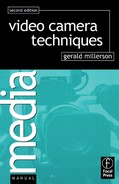There’s a great satisfaction in being able to operate a camera reliably and effortlessly. But this precision only comes through practice. So we’ve included a number of exercises here, to help you to become familiar with typical camera moves. Do them slowly at first, building up to faster versions later. Videotape your efforts, to check your progress. A combination of these operations would test even the most experienced operator.
• Pan across a detailed wall surface (e.g. brickwork) at a very slow constant speed using wide, normal, then narrow lens angles, at different distances; keeping it in sharp focus throughout. Now tilt up/down slowly at a constant rate. This will give you the ‘feel’ of lens handling at different focal lengths.
• Pan across a scene containing a series of objects at different distances from the camera. Focus on each in turn: (a) pausing at each object; (b) quickly refocusing while still panning. Try this at different speeds and distances.
• Focus hard on a close foreground subject. Then tilt or pan to a distant subject, refocusing as you do so.
• Alter your camera height while keeping the subject exactly center frame. (Mark the picture center in your viewfinder if necessary.) Go from maximum to minimum camera height at different speeds. Shoot closer and closer subjects.
• Dolly in towards a newspaper pinned to a wall, continually refocusing for the sharpest picture. Use wide, normal and narrow lens angles in turn. Repeat the moves dollying out. Now try this with tabletop objects.
• Repeat these exercises, zooming instead of dollying.
• Truck (crab) the camera across the scene from left to right, then from right to left. Focus on objects at various distances as you move. Repeat the move, keeping one subject exactly in center frame throughout.
• Arc right round a stationary object, keeping it exactly center frame, using wide, normal and narrow lens angles.
• Without prefocusing, take a close shot of a nearby object, then tilt up and zoom in to some distant detail. Prefocus on the distant object and repeat.
• Set up a series of identical objects (e.g. playing cards, drink cans) in two parallel lines away from the camera. Dolly down this ‘avenue’. Then zoom to simulate dollying. Note the differences (proportions, relative distances).
• At various camera distances, alter the lens angle so that the subject size remains the same. Note how the apparent sizes and distances of other objects appear to change.
• At 150 mm (6 ins) from the end objects note the MFD and depth of field for different lens angles.
If you can enlist the help of one or two others, there are some regular situations that are well worth practicing —
Distortion and depth
• With the lens zoomed out, move up to a person until you have a close-up. Check the sharpness of the background and geometrical distortion of the face. Repeat with the lens zoomed in to a normal lens angle. Compare the effect. Finally, zoom in, and pull back until you have a mid shot. See the differences. If you take a head shot, you will find that the results are staggering!
Following movement
• Follow a person walking across the scene from left to right: in a long shot, then in a mid shot, and finally a close shot. Repeat this from right to left.
• Have someone walk slowly towards the camera from long shot to a close-up.
• Have them walk diagonally towards the camera (far left to near right) following an uneven left / right path.
• Try all the above using different lens angles and camera heights.
• With the person in the distance, zoom in until you have a mid shot. As they walk forward, zoom out to keep their image size constant.
• Have a person walk away from the camera slowly as you dolly after them, keeping the same shot size. Repeat the action walking towards the camera while you dolly backwards. (Take care!)
• Take a two-shot of people at different distances from the camera — e.g. at 2 m and 4 m (6.5 ft and 13 ft).
• Zoom right out, and check the depth of field available. See how far the focus control has to be turned to pull focus between the near and the far persons. Zoom in half way, and pull the camera back until the person in front is a similar size to previously. Repeat the depth of field and focus checks.
• Two people stand talking. Have one of them exit the shot, and – Hold the frame still. Notice that the picture now looks unbalanced? Reframe the shot unobtrusively (without zooming in), to centralize the person left.
• Have a single person center frame. As the second person joins them, zoom out and reframe the shot to correct the composition.
Obviously there are innumerable permutations on these exercises, but these are the stepping stones to smooth, reliable camerawork. When you have mastered these mechanics, you will be free to concentrate on the deeply satisfying process of using your camera as a creative tool.
